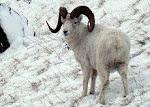Monday, February 21, 2011
Pronghorn Antelope
This particular wild animal is likely the most misunderstood animal in North America. However, it is one of the most visible and typically taken for granted by the passing motorist. The population will range from Canada to the southern border of the United States. In the heavier concentration areas, you will see the Pronghorn Antelope in the rolling plains alongside most highways.
One of most least known facts of the Pronghorn Antelope is that the scientific name, Antilocapra Americana means "American Antelope Goat". However, this deer like animal is neither antelope nor goat. It is the surviving member of an ancient family dating back 20 million years. For practical purposes it is most often referred to as a Pronghorn Antelope.
The Pronghorn is the only animal in the world with branched horns (not antlers) and the only animal that will shed its horns, as if they were antlers. All species of wild sheep and the Mountain Goat also have horns, but they are not branch and they do not shed the horns. The antlered species; Deer, Elk, Moose, and Caribou shed their antlers each fall or by mid winter.
When you glance at the Pronghorn Antelope, they are a smaller animal but again what most people do not realize is that they are the fastest animal in the western hemisphere. They have the ability to run with 20 foot bounds at speeds up to 60 mph. Unlike the Cheetah, the speed burner of the African plains, the Pronghorn Antelope can run for hours at a fast pace.
Beside their speed, they use their eyesight to warn them of danger, having the ability to view as far away as four miles. The rear end of the Pronghorn Antelope has white hair and is utilized as a warning device for the other animals in the herd or band. When running, the white hair will ruffle and stand out as a signal to other animals of danger. When ruffled, other Antelope can detect the warning up to two miles away.
In the last two years, I have spent many hours sitting and watching the Pronghorn Antelope. Both times were just prior to the rutting season or during the rut. The male or Buck will spend a great deal of time scenting his area or developing urination holes to attract the females or Does to his band. The typical band during the rutting season will range from four to a dozen Does. The Buck will constantly remain alert to potential raiding Bucks. When a potential raiding Buck appears, they will spend some time staring each other down at a safe distance. Then one will break and charge the opponent hoping to chase him away. I have sat and watch one Buck chase another Buck for quite some distance before returning to his Does.
This past fall while in the Black Hills of South Dakota, I also noted that it was not unusual to see females or Mule Deer Does also mingled in with the Pronghorn Antelope Does. They are a great animal to sit and observe but very difficult to stalk and get in close to them. Typically when I am in an area with Pronghorn Antelope, I will carry a white plastic bag with me. If detected and the herd starts to run, by standing and waving the bag, the Buck will stop and stand his ground long enough to get a couple of quick camera shots. I am assuming the "white bag" waving is similar to their rump hair as a danger warning and they stop long enough to determine the danger. The are a great animal to photograph.
"Pronghorn Buck Scenting The Brush"
"Alerted To Potential Danger"
"Feeding At Sunrise"
"Sunrise"
"Checking Out His Urination Hole"
"Moving To Intercept A Rival Buck"
"Rival Buck Approaching His Area"
Subscribe to:
Post Comments (Atom)






















No comments:
Post a Comment